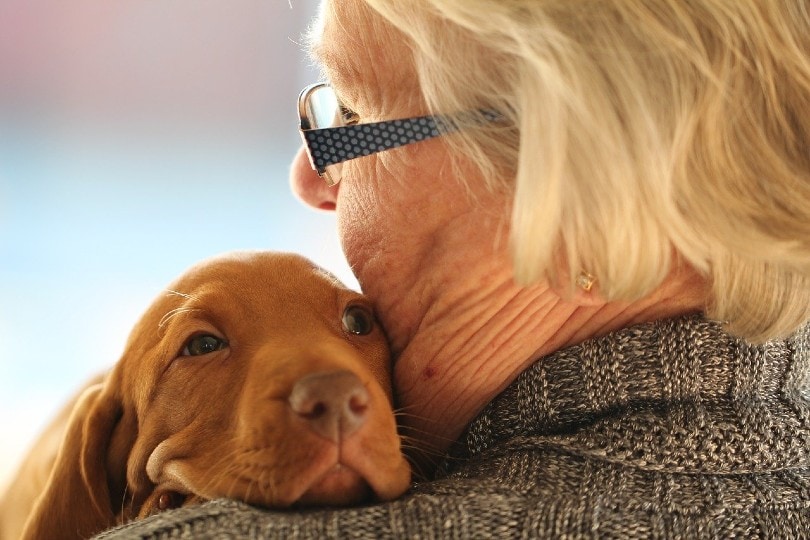Click to Skip Ahead
One of the oldest known hunting dogs in the world is the Vizsla, and they were first bred in Hungary. These beautiful dogs are excellent in the field and in the home and are known to be extremely high-energy canines. Vizslas also make strong bonds with their owners and are loyal to their core.
Vizslas thrive in homes where their owners give them attention, affection, and training time. They do best with ample space to run, play and work off their boundless energy. Are you curious to find out how long Vizslas live and which factors help them live longer and healthier lives? Vizslas live between 11 and 15 years. Read on to learn more.
What’s the Average Lifespan of a Vizsla?
You’ll be pleased to know that the average Vizsla is a healthy dog that lives to a relatively ripe old age. Vizslas live between 11 and 15 years. Of course, as with all dogs, the lifespan of your pet will be affected by many factors.
Why Do Some Vizslas Live Longer Than Others?
We’ve broken down the most important factors affecting the Vizsla’s lifespan below.
1. Nutrition
As a puppy, your Vizsla will need puppy food that has at least 23% protein and about 8% fat. Once an adult, these needs change slightly, with about 20% less protein and fat required. Older Vizslas need a more digestible diet with fewer calories, but none of their life stages demands high carbs. No matter the food you feed your pet, a premium protein such as fish, beef, lamb, or chicken must be included. It’s also critical that you keep snacks to a minimum since Vizslas can become overweight.

2. Environment and Conditions
The living environment for a Vizsla is crucial for a long, healthy life. They don’t do well housed outside, and they form very strong bonds with their owners. If socialized well, a Vizsla will get along fine with other dogs and cats and will be fantastic with children. However, they can suffer from separation anxiety and will do best with an owner that’s home more often than a3.way.
3. Enclosure Size/Living Quarters/Housing
Vizslas are highly energetic dogs that need a large environment to thrive, stay active, and remain healthy throughout their lives. These aren’t apartment dogs and will not do well in a small environment, even if there’s green space available. Vizslas grow strong attachments to their owners and should be given a bed near them so that they sleep well at night.

4. Size
As a medium-sized dog, the average Vizsla usually lives longer than large and extra-large dogs. Of course, all of the other elements on this list will contribute to their longevity, especially their nutrition and activity levels. In other words, size isn’t a significant factor in how long your Vizsla will live.
5. Sex
There are few studies on which Vizsla sex lives longer, but anecdotal evidence shows that female dogs typically outlive their male peers. As with all dogs, spaying or neutering your Vizsla will usually increase its lifespan by 18 to 20%.

6. Genes
You’ll be pleased to know that Vizslas are a healthy breed that hasn’t experienced problems with overbreeding. This has ensured that, unlike many other dogs, Vizslas have fewer genetic conditions that affect their health and lifespan. The most common health conditions that affect Vizslas are canine epilepsy, joint problems such as hip dysplasia, and eye conditions including glaucoma, canine cataracts, distichiasis, and canine entropion.
7. Breeding History
As with all purebred dogs, you must find a reputable, caring, and conscientious breeder when adopting a Vizsla. This will significantly reduce the chance that your puppy will have health issues when it becomes an adult.

8. Healthcare
Regular veterinarian visits and checkups are the definitive methods of ensuring your Vizsla remains healthy. Ensuring they’ve been vaccinated is also critical, as well as keeping your Vizsla away from possible health risks like drinking from contaminated puddles or being exposed to sick or otherwise unhealthy animals.
The 4 Life Stages of a Vizsla
1. Puppy (0 – 6 months)

It’s critical that you socialize your Vizsla well as a puppy to prevent any aggression or anxiety issues once they become an adult. Socialization can begin around 5 weeks of age and continues at least until 12 weeks (if not longer).
2. Juvenile (6 – 18 months)
This period is when your Vizsla will realize that it’s part of your “pack” and will likely challenge you for dominance. For these reasons, you must train your Vizsla well and teach it that you’re the pack leader. If not, aggression issues may result. This is also the best time to have your puppy spayed or neutered so that their aggression and sexual behavior are decreased.
3. Mature Adult (18 months – 10 years)

Although Vizslas reach their full adult size between 6 and 8 months, they don’t fully mature until they reach about 2 years old. If they’ve been well-trained and socialized, a Vizsla will calm down and be well-behaved. However, an adult Vizsla will have nearly as much energy, often more, than a puppy.
4. Senior (10+ years)
Older Vizslas will begin to lose muscle mass, and their coat will also change color. Most will eat less and be less active, with less enthusiasm for playing games, going for walks, and other activities. Health conditions can also become more prevalent, as well as separation anxiety and potty issues. Senior Vizslas will also have more problems responding to commands and will see their eyesight and sense of smell diminished.
How to Tell Your Vizsla’s Age
Like most dogs, there are telltale signs that a dog is young, middle-aged, or older. However, unless you know your Vizslas birthday or purchased them from a breeder, determining its exact age will be difficult. The best things to check are their teeth, coat, and eyes, which will all show signs of aging. Your pet’s paw pads and energy level are also helpful in determining if they’re young or older. Missing or damaged teeth, cloudy eyes, and mobility problems typically indicate that a Vizsla is a senior. For a more accurate estimation, visit your vet for an examination.

Final Thoughts
Vizslas are longer-lived dogs than most breeds and can live 15 years. They don’t suffer from many genetic issues, which further enhances their longevity. It’s worth repeating that Vizslas are active dogs requiring a lot of mental and physical stimulation to remain healthy and live longer lives.
When well cared for, the typical Vizsla will be around for a long time and be a wonderful, affectionate, and fun-loving pet that will stick by your side through thick and thin.
Featured Image Credit: Vizslafotozas, Pixabay











